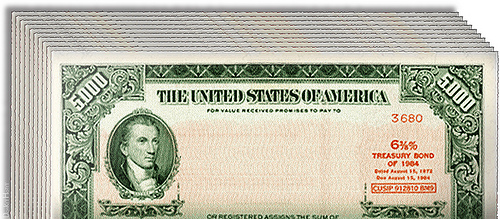When first getting into investing, there is a lot that you’re going to need to learn. One thing that many people don’t realize at first is that there are many different types of bonds. Understanding bonds can help you understand your investments better. Get to know some of the bonds available.
1. U.S. Treasury Bonds
Image via Flickr by DonkeyHotey
If you’re looking for a safe investment, considering a U.S. Treasury bond. These are considered one of the safest investments available, even during the economic problems that the United States has had over the last few years. With a Treasury bond, you don’t have to worry about the risk to interest rated or default. On the down side, Treasury bonds generally have a much lower yield than many other investment options. Treasury bonds have a varying number of years until they mature, so make sure you keep this in mind when investing.
2. Savings Bonds
Even safer than Treasury bonds, savings bonds are generally the lowest yielding, but most steady bond option. This is one reason why many adults purchase savings bonds for the children in their lives. There is little to no risk of losing money with a savings bond. They are tax-free, as well. There are penalties if a savings bond is cashed in within the first five years. In addition, they can’t be cashed in at all in the first year. So, if you’re looking for something fluid, this isn’t the best option.
3. Asset-Backed Securities
If you’re interested in purchasing individual asset-backed securities, you’re going to have to do some research. These are loans that get packaged and sold. You need to be able to take a look at the loans and evaluate them to ensure that you’re getting a good deal. If you need an investment banker to help you, you can find all of Fisher Investments addresses, and contact the closest branch for more assistance with your investments.
4. Corporate Bonds
Companies need money to fund their business and operations. Because of this, many companies will issue bonds to pay for this. If you’re looking for a bond with a higher yield than government bonds offer, consider a corporate bond. On the downside to this, with a higher yield comes a higher risk. There are several options, including short-term, long-term, low risk, and high risk, as well as everything in between. It simply depends on the company and the bond being issued.
5. Emerging Market Bonds
There are many countries that are still in the developing stages. These are where emerging market bonds come from. Both the nations themselves and the companies within these nations offer bonds to those who are in more developed countries. These are generally more high risk bonds, because developing countries are more likely to have economic swings and other disruptions that can cause problems within the market. On the flip side, emerging market bonds usually offer much higher yields to help balance out the risks involved. This is a great option if you’re interested in the payout, and not too worried about the risk.
6. Callable Bonds
Callable, or redeemable bonds are an option that allow the company who issues the bond to call it back before it matures. This is an interesting option to have in your portfolio, because bonds can be called back for nearly anything. In most cases this happens when interest rates drop. This allows companies to save money on their debt. This is not usually the most beneficial option for those who are investing, because you are going to get a lower yield on the bond.
Deciding on the type of bond you want to invest in can be a frustrating process if you don’t know what you’re doing. Working with an investment firm can help you, as they are able to assess your needs and what type of bond would be best for your portfolio. When discussing this with an investment firm, it’s a good idea to go in with some information on what you’re interested in, so that you can work together to create your portfolio.
For more on this topic, check out our posting on Bond Basics

